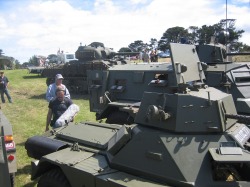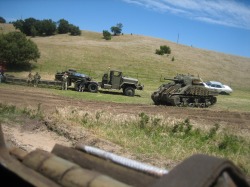|
Location Cape Shanck Equipment Zoom H4N Rode NTG3 Boom Pole Array and Zoom H4 Sennheiser MKH60 DPA 4061 Mounted Well it took a couple of weeks to organise, but as promised today I went to play with some tanks. I was worried the weather was going to betray me again, but it turned out to be a fantastic day. (so nice I got sunburned again even though I used sunscreen). We drove down to the Mornington Peninsular where there is a ranch where you can go for rides in the tanks. Today was a member’s only event for the Victorian Military Vehicle Corps, but I had gotten prior permission so we were allowed to come along. The first thing I noticed was that there were a lot of vehicles around and that there was no way I was going to be able to do a full recording of all of them. I had come for tanks so I thought I would concentrate on them, and anything else was just icing on the cake. The main tank on the property was a British Centurion tank. This was one of the most widely used tanks since World War 2. Originally of British design, Australia used them in the Vietnam war. They were active around the world from 1945 right up to the 1990’s. I have no experience with recording tanks, so it was a day of trial and error. I mounted some mics onto the back of the turret on the Centurion. There is a cage at the back that I think is used to carry jerry cans of water or fuel. The good thing about the cage is that if any of the mics came loose they would fall into the cage and not get lost. Also the cage was positioned pretty much right over the main engine so it was a good location. I used the Zoom H4 as I wanted to keep the H4N on me. I mounted one of the DPA 4061 mics and then strapped the MKH60 in its blimp cover to one of the cross bars with a roll of Velcro tape I had recently bought. I think this Velcro is going to be really useful in the future. I had had really good timing this week as my new Rode blimp had arrived just on Friday so I could use both the MKH60 and the Rode NTG3 in blimps which was excellent. I think I will need to make future trips just to get a full recording of this one tank alone. I did capture some excellent material, but I would like to grab some more sounds of the caterpillar tracks isolated from other sounds.. The Centurion was not going to be used till much later in the day. One issue with a casual event such as this is it is difficult for me to plan what to do and when. I might have been able to use the mics on other vehicles, but I was determined to get a good recording of the centurion so I left those mics where they were and used the NTG3 and H4N for everything else. I did spend quit a lot of time chasing after vehicles, standing behind them when they were idling or positioning myself on corners to catch them as they zoomed past. One of the club members has an air force Humvee which I think I am going to do a feature on as it’s an excellent example of a modern military vehicle. (And sounds great) There were also lots of jeeps and a couple of land rovers which I decided to leave for future dates. I did capture quite a bit of material from an FV603 Saracen APC. This is a British made vehicle used from the early 1950’s to the late 60’s. The Saracen had an entirely metal suspension system which on a vehicle this old meant it squeaked and creaked a lot. This might not be good for creeping up on the enemy, but it certainly made it sound more interesting. This one had a little trouble starting up and they needed to use another armoured car to jump start it. I even captured some material inside the Saracen by setting my R09 recording it and asking a young guy to hold it for me while he went for a ride, he was happy to help and I got some good material. Two gentlemen had a converted Bren Gun Carrier that their grandfather had built years ago. It had had a lot of the armour removed from it so it could be used for farming, but it still operated well and sounded really good. They kindly took me for a ride in it. The small size of the carrier allowed me to lean over the front and capture some sound from a different angle, as well as the usual close micing of the engine. The tracks on the Bren Carrier were quieter than I expected, that might have been due to the vehicle being a lot lighter than a full sized tank. The engine overheated a little towards the end, but it was a tough little tank and had a very distinctive sound that I liked. Between riding in it and following it around for a while I think I probably captured as much of that vehicle as I would ever need, so it was good to get such a good range of sounds without needing to attach extra mics to it. I managed to grab some snippets of other vehicles during the day. A tank transport truck, a Ferret armoured car, the siren of a US Army Jeep. These were simple captures made by positioning myself in a good position and recording with the NTG3 on the boom pole. The pole itself is handy for quickly changing positions and allowing me to angle the mic under a vehicle, or close to its exhaust or from above. Once I have captured some material from one angle I will usually walk around the vehicle to test how the sound changes. Some vehicles produce a very different sound from different angles. The exhaust usually has much more low frequency material where as the front end will include the sounds of cooling fans and drive belts that can’t be heard elsewhere. I can’t always capture every angle, but when I have time I captures as much as I can. The boom also allows me to position the mic closer to where a vehicle will be when it comes around a corner. As much as I don’t want my equipment getting run over, it is a much better option to have a tank run over one of my mics than to run over me, so it can be a good safety function as well. When it came to the Centurion tank I made sure I was on top of it when it started up. It has two engines, a secondary engine that is used to power a lot of the electrical equipment on board also helps start up the primary engine. I captured a good clean sequence of the secondary engine starting up and running for a few minutes before the main engine started. I also captured the main engine from several positions before they started moving the tank. The attached mics captured a good constant amount of material as the tank was driven around. This combined with me following the tank with the boom pole gave me a good mix of close and distant mic samples. The only thing I really missed was some good track movement noise. I think next time I will mount some mics right at the front of the tank on the track guards just over the front curve in the tracks. This should be far enough away from the engine at the rear to capture some good clunks and squeaks from the tracks without too much engine noise. This was a good lesson to learn, but even if I had known this beforehand I didn’t have a third recorder with me on the day anyway so I wouldn’t have been able to do it all in one recording. I am happy with what I did capture, but a tank is a complex enough vehicle that I think it requires more mics that a standard car or truck. These are all good lessons to learn for next time. The final vehicle for the day was the Sherman tank. I only captured this one with the boom pole setup as I didn’t have time to transfer the mics from the Centurion onto the Sherman, but I still got some excellent material. The Sherman has a new engine in it as it was restored to use in a movie. The engine is a massive and noisy thing that produced the most amazing sound. This combined with the tank’s driver who was very good and could control the vehicle as well as any racing driver provided an incredible series of sound samples. Tanks are also very interesting to record from a distance, and the property allowed the tanks to be 300-400 meters away behind a small hill. The main thing I noticed is that when a tank is moving away from you, you can hear the low frequency rumble of its exhaust, but when a tank is travelling towards you, you hear far more of its track squeak than its engine. I suspect this information is something that a lot of soldiers around the world are very aware of and use as a survival skill. It is important to point out that sound over distance change a lot more than just getting quieter. While you can simulate a distant sound by playing it at a lower volume most sounds change dramatically as certain frequencies are easier to hear over distance. So when you are recording it is worth capturing distant samples as well if it is possible and practical.
I plan on meeting with the people from VMVC again and eventually archiving as many of their vehicles as possible. Not only are military vehicles something that are popular subjects fro films and games, but they often have very distinctive and interesting sounds, so I think the time will be well spent, not to mention its loads of fun. Website www.vmvc.org.au/
0 Comments
Leave a Reply. |
AuthorStephan Schütze has been recording sounds for over twenty years. This journal logs his thoughts and experiences Categories
All
Archives
April 2019
|




 RSS Feed
RSS Feed
